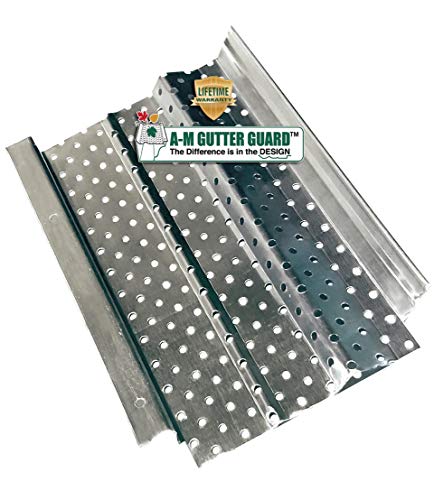The primary function of gutters is to channel rainwater from your roof, through downspouts, and to direct the rainwater away from the foundations of your home. Depending on where you live, this can range from helpful to vital. But a banging gutter can leave you questioning just how much you really need it!
The noise is annoying but it can also indicate that something is not right with your gutter system, and you may save yourself some hefty water damage repair bills if you head onto the roof to see what could be making the gutter respond so noisily to the wind. Happily, fixing noisy gutters is an easy DIY task!

The primary cause of noisy gutters is damaged or broken guttering, downspouts, and brackets. Strong winds blow the broken or loose parts, causing them to scrape and bang against each other or the walls of your house. Regular maintenance will prevent most gutter noises.
Gutter Loose in Brackets
Gutters and downspouts that are loose in their brackets will vibrate and scrape against the metal of the bracket, creating a noise whenever they move, such as on a windy or stormy day.
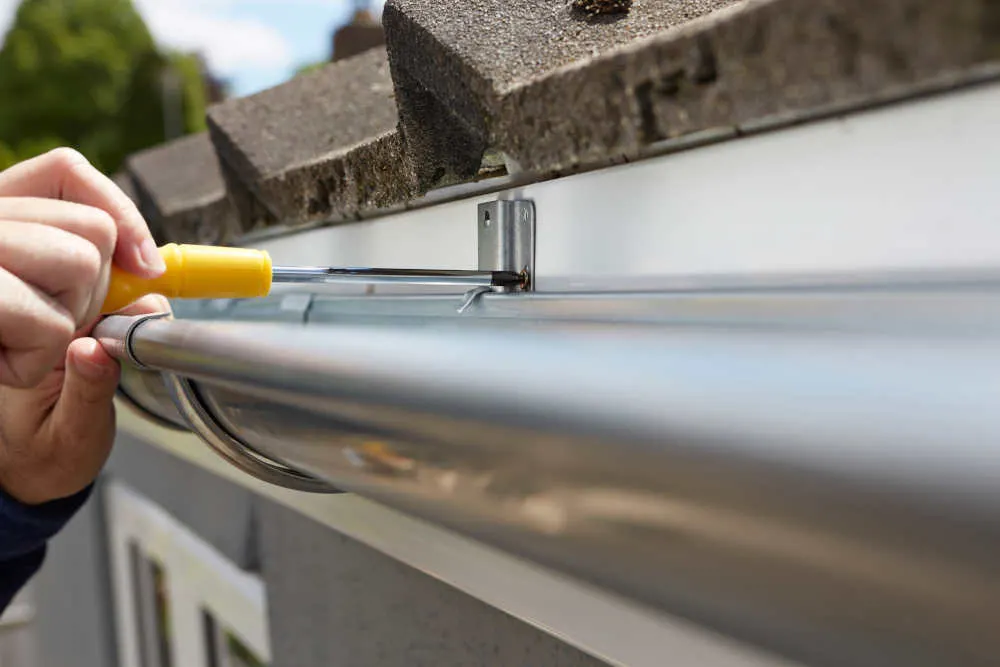
There are many different ways that gutters can become loose in their brackets:
- Gutters can become damaged during heavy windstorms or rainstorms due to the force of the storm.
- Hail, sleet, and snow can build up on the gutters or create holes causing them to sag and the brackets to bend so that they no longer fit snugly around the gutter.
- Sunlight can damage the gutters and cause them to become brittle and break within the bracket.
- The gutter material could expand in warmer weather and then contract again, causing the brackets to move out of place.
- The fasteners holding the gutters in place on the brackets may have aged and become loose or fallen out.
How To Fix Loose Gutters in Brackets
Repairing loose gutters could be a quick fix—as simple as rearranging or rehanging them. If that doesn’t work, replace sections of the gutter or even the bracket itself. Check for and secure any loose fastenings in the brackets before replacing them.
There are not too many ways to prevent gutters from coming loose in their brackets as this is a symptom of wear and tear natural to something that is constantly exposed to the outside elements.
However, you should check them regularly and repair or replace any damaged areas before they become too problematic or cause a ripple effect of loosening.
By this, I mean that when one portion of the gutter is loose in its bracket, it can move more and generate more force, which becomes enough to start loosening the next section of the gutter.
Furthermore, if you are installing new gutters, check that they are correctly installed to start with.
Brackets Loose on Wall or Roof
If the brackets holding the gutters and downpipes onto the roof or wall become loose, the resulting scrapping or banging against the roof tiles and walls can become a real nuisance!
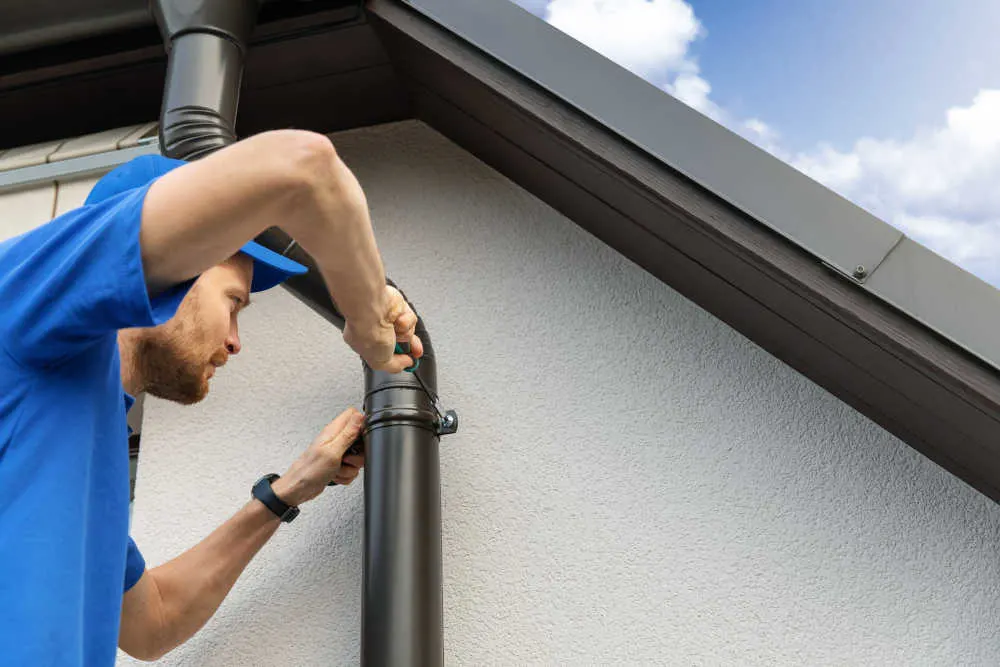
Brackets could loosen for various reasons:
- Debris could build up in the gutters. The extra or uneven weight causes the brackets to loosen or sag.
- The fasteners holding the brackets against the wall or roof may have perished due to natural aging or extreme weather conditions.
- Strong wind and rainstorms buffering against the gutters can not only loosen the brackets around the gutters, but can cause the brackets themselves to pull away from the wall or roof.
- In colder climates, ice dams could form, running over the gutters, and causing the brackets to loosen or break.
How To Fix Loose Brackets
To repair a loose bracket involves replacing or tightening the fasteners or replacing the bracket itself.
Routine, regular gutter maintenance and cleaning will help with fixing loose brackets before they become a problem.
Don’t neglect to check the downspout straps, especially if they are hidden behind foliage—they could be responsible for that scrapping or banging noise that you hear often!
Downspout and Gutters Not Connected Properly
Sometimes, sections of the gutters and downspouts are not connected properly. Then, when the weather turns windy, you get a loud banging or irritating grating noise as a result of the following:
- Loose guttering hitting against each other.
- Loose guttering hitting a wall or the roof.
- Loose downspouts blowing against the wall or the gutter in the wind.
- Gutters and downspounts scraping or hitting against each other at the point where they are supposed to be joined securely.
Many of these problems are caused by:
- Faulty installations.
- Mismatched gutters and downspouts.
- Not enough brackets to secure the gutters and downspouts in place.
- Heavy debris in the gutters causing the brackets to break.
How To Fix Improper Connections
To fix any of these problems involves replacing the gutter, downspouts, and brackets if they are faulty, or re-aligning the gutters and downspouts, and tightening the bracket fasteners.
Routine maintenance should prevent any further problems as loose parts should be realigned and tightened.
When the gutters are installed, ensure that all the gutters and downspouts are the same size to prevent these problems.
If the sizes are different, rather wait until you have all the correct sizes before you install—don’t force them fit to get the job done!
Is the Wind Damaging My Gutters?
Although wind can cause severe damage to gutters, most gutters are strong enough to withstand wind storms reasonably well for the duration of their expected lifespan.
Most of the damage is not caused by the wind but by the debris blown around during a storm.
- Flying debris and objects can inflict severe damage on gutters and downspouts. While dings and dents in the gutter metal are typical, heavier objects can dislodge gutters and cause them to break and fall. A flying gutter piece can be very dangerous!
- Strong winds can cause metal fatigue. The constant backward and forwards movements of the gutters blowing in the wind weakens the metal causing cracks in the gutters and dislodges the fasteners and brackets holding the gutters in place.
- Large debris trapped in the gutters can rattle and bang around when rainwater gushes through the gutters.
- Moving debris blown by the wind can severely damage caulk or coatings in the gutter trough.
Additional Sources of Gutter Noise
Most gutter noise results from stormy weather, the breaking of equipment, or a lack of regular maintenance.
Without regular cleaning, gutters will become clogged and backed up with all kinds of debris, causing water to drip and not flow down the gutters and downspouts as intended, creating all manner of noises.
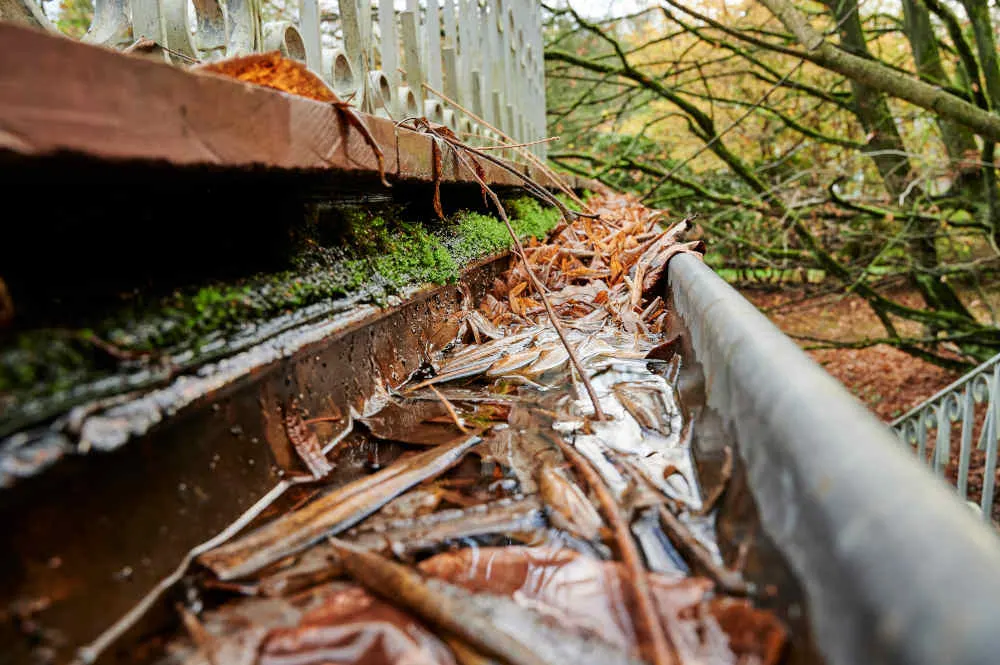
Blocked Gutters
When rainwater flows smoothly through a gutter and the downspout, the gutter is doing its job of protecting the house.
When rainwater is backed up due to clogged debris, the water traveling along the gutters does so turbulently, creating noise.
An even more concerning result of such clogs is the fact that the gutter cannot function as it should. Water that cannot travel along the gutters is forced to find another exit point. That exit point is generally over the sides of the gutter!
Not only will rainwater overflow from the gutters, but it will carry with it all the debris that is being dragged along the gutter, often damaging your walls on the way down!
Water pouring over a gutter instead of being channeled along it can cause damage to the ground below—pooling water is no good for your house foundations!
The Fix
To prevent blocked and clogged gutters, clean and clear out your gutters regularly and perform regular maintenance. Your gutters should be cleaned before the rainy season starts and often throughout the season to keep the gutters clear and working well.
Install a gutter cover like the one pictured above to prevent leaves, twigs, and other windstorm debris from collecting in your gutters. The cover is placed over the top of the gutters to collect any loose leaves and twigs that may fall in, preventing the brackets from buckling and breaking due to the added weight.
- ✅ These are SAMPLES only - 7 inches in length.
- ✅ The Difference is In the Design. Heavy (Industrial) Gauge .018 100% Aluminum will not rust - Lifetime warranty covers no rust, rot or product self deterioration specifically for hidden hangars but...
- ✅ Designed to handle downpours with 380 - 1/8" holes per linear foot
- ✅ Virtually invisible from the ground
Last update on 2024-03-27 / Affiliate links / Images from Amazon Product Advertising API
As a last resort, if you live in a high rainfall area, invest in gutters with a larger capacity to allow more water to flow along them at a time.
Poorly Angled Downspout
Downspouts, like gutters, should be installed correctly for them to do their job properly.
The gutters should be installed at a slight tilt to allow rainwater to flow unhindered down the spout to the drains. A slope of 0,25″ every 10 ft (6.35 mm) is the recommended gutter installation angle. With the pitch at this angle, gravity pulls the water down the gutters and into the downspout in a constant flow.
The correct angle prevents water from building up near the roof and overflowing onto the ground (which can sound like a constant wave crashing over your house!) or into the eaves. Excess water buildup in the eaves can cause the wood to grow mold and rot, resulting in a costly repair bill!
In addition, if the downspouts are too straight, water will not flow down the sides of the downspout. Instead, it will drip from the gutters, causing an irritating jarring sound each time the drop hits the lower elbow of the spout.
So, what’s the best angle for a downspout? An elbow connects the gutter to the downspout and channels the water at the bottom of the downspout. The standard elbow angle is 75 degrees, but they do come in a range of sizes from 30 to 90-degree angles for different uses.
The Fix
Adjusting the angle of the gutters and downspout should allow the water to flow and stop dripping into the elbows. (The lower downspout elbow should extend at least 5 ft from the house to channel water away from the home).
Vibrations and dripping sounds can be muffled by insulating the downspout with thick foam insulators.
Replace the metal lower elbow on the downspout with a PVC or vinyl elbow. Metal causes the drips to echo, whereas PVC and vinyl should muffle the sound.
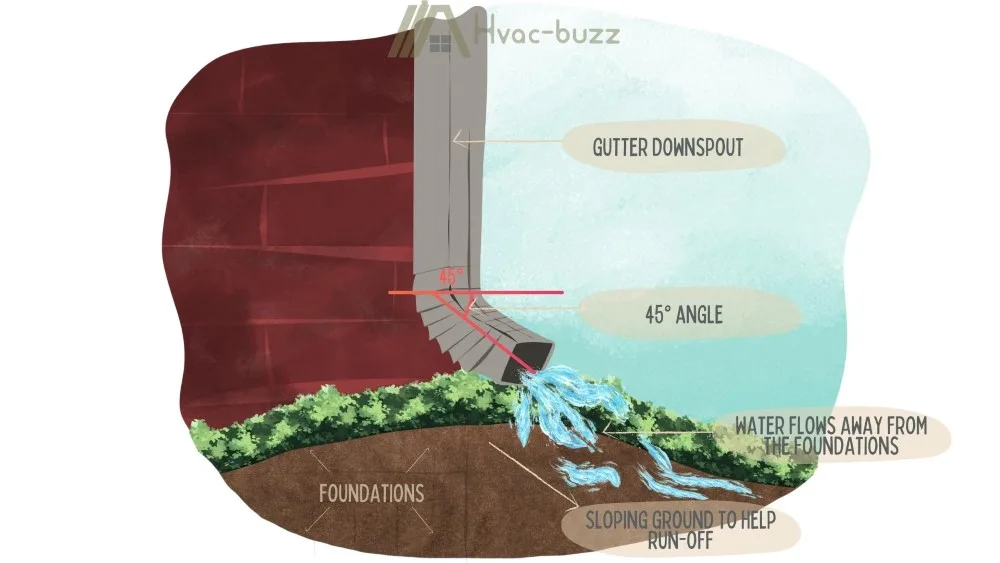
Animals Living in Your Gutter
Backed-up gutters could potentially attract birds and pests to your home. Small birds could build nests in the debris, and stagnant water and decaying matter are an excellent breeding ground for insects! Insects, in turn, attract more birds who will forage in the stagnant water.
Rodents could be attracted to the bird’s nests and build their nests in the eaves, gutters, and downpipes of your house. While rodents, birds, and pests might cause parts of the gutters and brackets to break, they also add their own rustling and scuffling sounds to the mix!
Keeping your gutters clean will prevent noisy critters from nesting in your gutters and roof!
Should You Remove Your Gutter?
When you become aware of a noise, particularly a noise that you find annoying or offensive, it’s very difficult to send it out of your awareness again.
It might drive you crazy enough that you’d consider ripping all the gutters off rather than trying to figure out and fix what is causing the rattling.
While extreme, this is an option because rain gutters are not required by code. However, doing so will definitely create other issues, so you need to assess what you are willing to live with.
If you’ve ever wondered why beach houses don’t have gutters, you can read through the potential reasons and the likelihood of each here.
Sources
https://www.shackshine.com/common-gutter-problems/
https://www.hinkleroofing.com/gutters/3-reasons-behind-noisy-gutters-and-downspouts/
https://www.fellerroofingnb.com/blog/roofing/why-are-your-gutters-and-downspouts-making-noise/
https://www.gutterhelmet.com/blog/5-tips-for-silencing-noisy-rain-gutter-downspouts/
https://www.barrybest.com/blog/gutter-helmet/how-to-fix-noisy-gutters/
https://findanyanswer.com/how-do-you-angle-a-gutter-downspout


